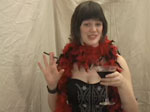
Course: WGST 51/COLT 39 – Mirror, Mirror on the Wall
Instructor: Nancy Canepa
The Basics.
For your major project in this course you will be making a video together with 2 other students (i.e., groups of 3). Group selection is up to you; given the nature of the project, choose people whom you not only get along with, but who share your ideas on interesting directions in which to expand your experiences with fairy tales. You’ll make your videos using iMovie, and with the extensive help of the Jones Media Center (see syllabus for various instructional and tutorial sessions). Each video should be 5-7 minutes (please: no LONGER than 7 minutes!).
How to start thinking about it.
In your video you’ll be adapting or relating a fairy-tale type, paradigm, or set of motifs that you have encountered in the course to your own personal experience or to some aspect of modern life. The video may take a number of forms: theatrical/ cinematographic dramatization of a fairy tale (in whatever temporal and spatial dimension you like); a dramatized telling (incorporating visual material); a musical rendition (e.g., MTV-type video); a dramatized interview with one or more characters from a tale; a narration in images, etc. etc.! I’m open to and interested in other ideas, of course, but make sure to share them with me before you embark on the project.
How to frame your fairytale.
Approaches to “retelling” the tale or reconfiguring the motifs you choose may involve reversals of fairy-tale patterns or character types we have seen; sequels or prequels to familiar tale types; shifts in narration (e.g., from an objective 3rd-person narrator to a 1st-person narrator [one of the characters of the tale], or to an unreliable 3rd-person narrator); reframing the tale (e.g., changing its temporal and/or spatial coordinates); reinterpreting or zooming in on single episodes, elements, or characters of a tale.
The nitty gritty.
Throughout the process I will be distributing handouts to help you with the various phases of the project. To give you an idea of this process, these are the main steps:
- Choose your group, and brainstorm about possible ideas for your video.
- Create a proposal, and complete the treatment plan. (I’ll give you a form to help you.) Hand in a narrative summary of proposal/treatment (500 words).
- Showcase your ideas in a “pitch session” in which each group will have 5 minutes to present their proposal and then receive feedback from the rest of the class.
- Participate in 2 Imovie tutorials at Jones Media Center (during class hours), in which you’ll learn video-making techniques.
- Participate in 1 30-minute session in JMC before your group checks out a video camera.
- Put together a shot list (storyboard). This is optional. (Template provided.)
- Once footage is shot, participate in 1 or 2 editing sessions (depending on need) at JMC, with RWIT tutor.
- Complete video!
- Put together, as a class, pertinent criteria for evaluating the videos.
- Participate in a special showing of your videos.
- Write and hand in evaluations (both formal, based on class criteria, and less formal) (500 words).
Example of a Final Project
[youtube zek0yaetAUI]

